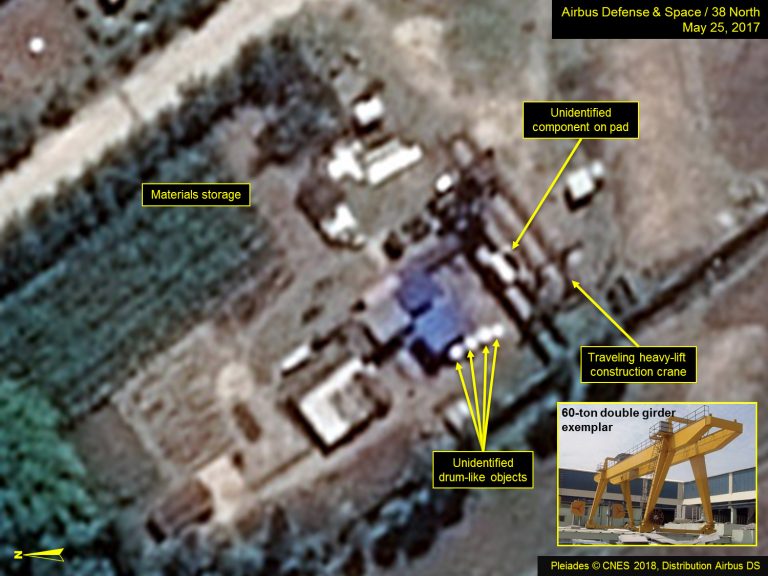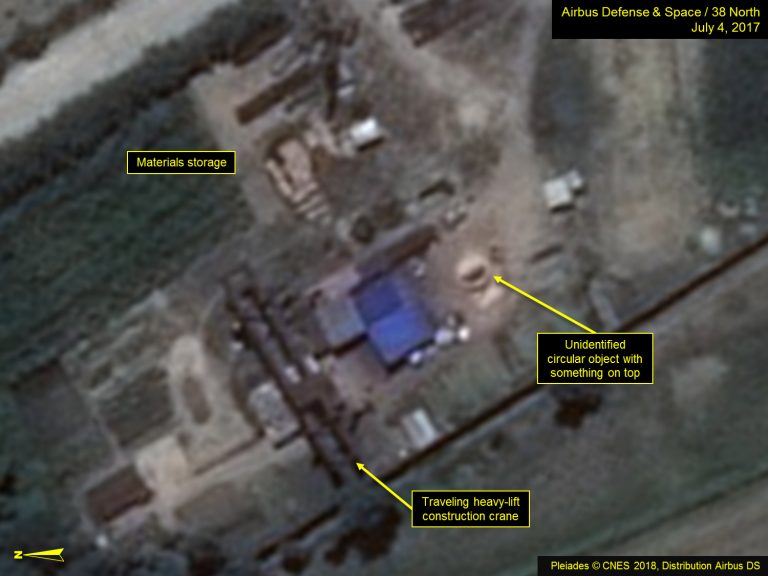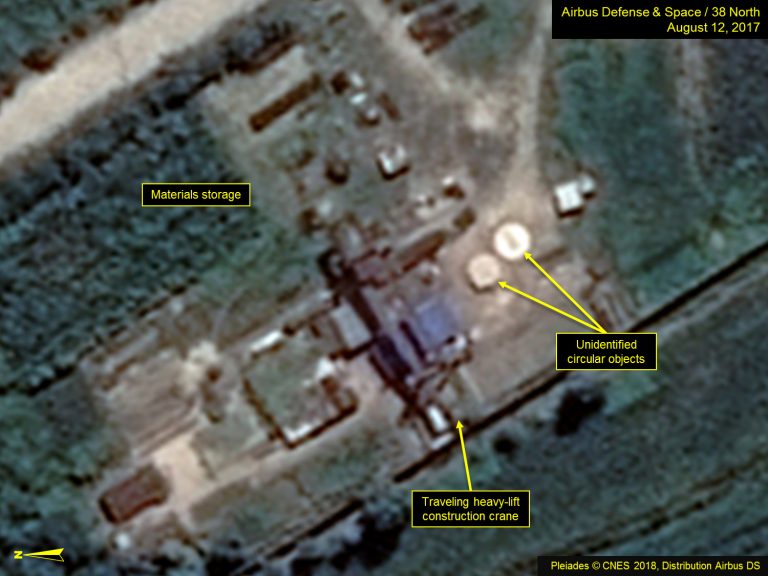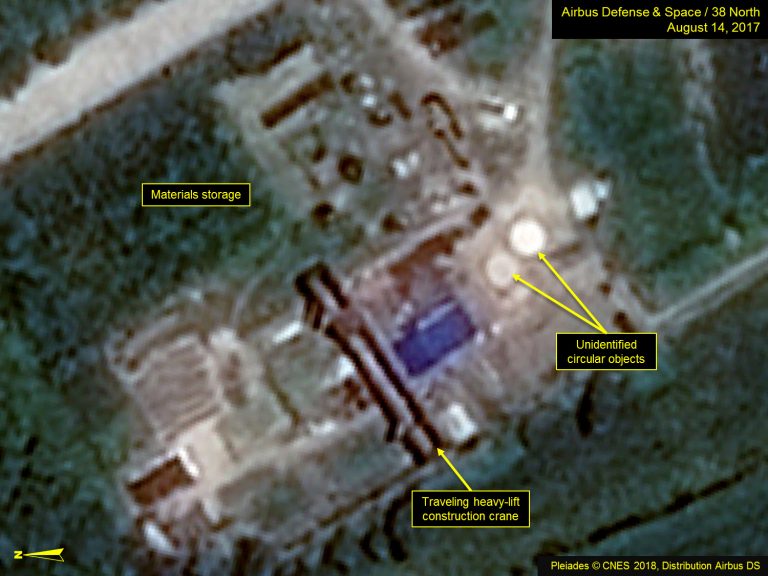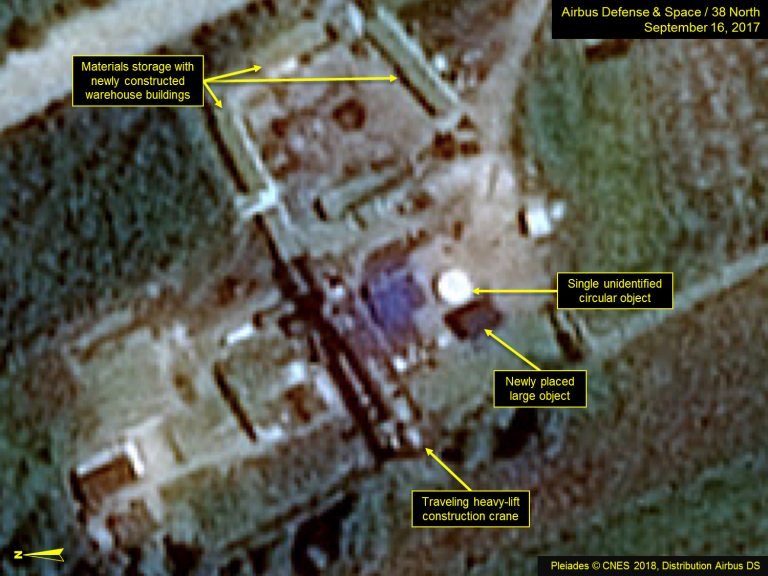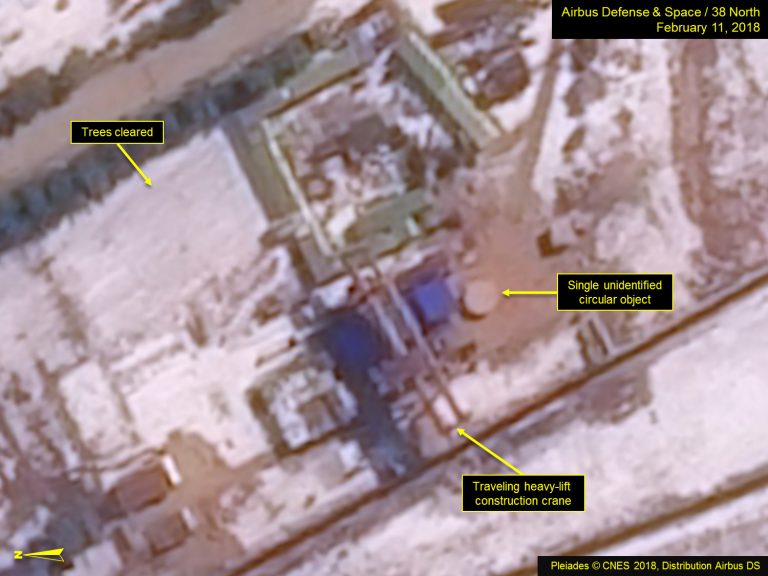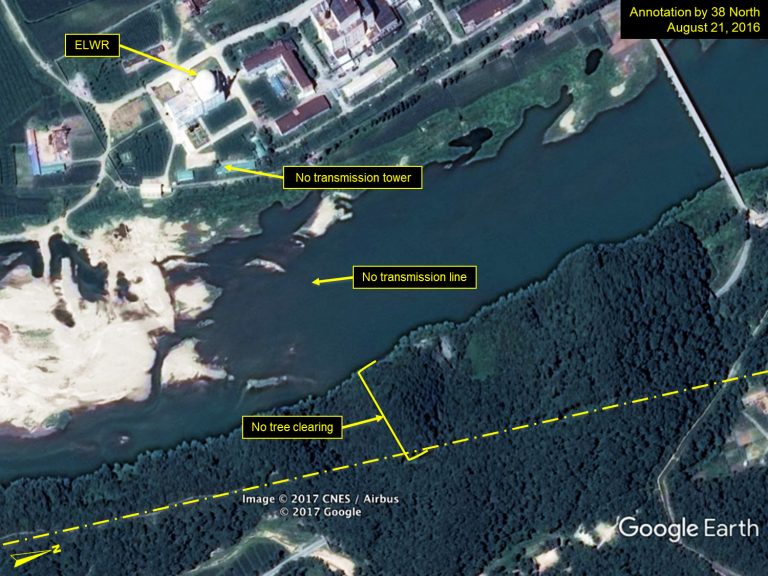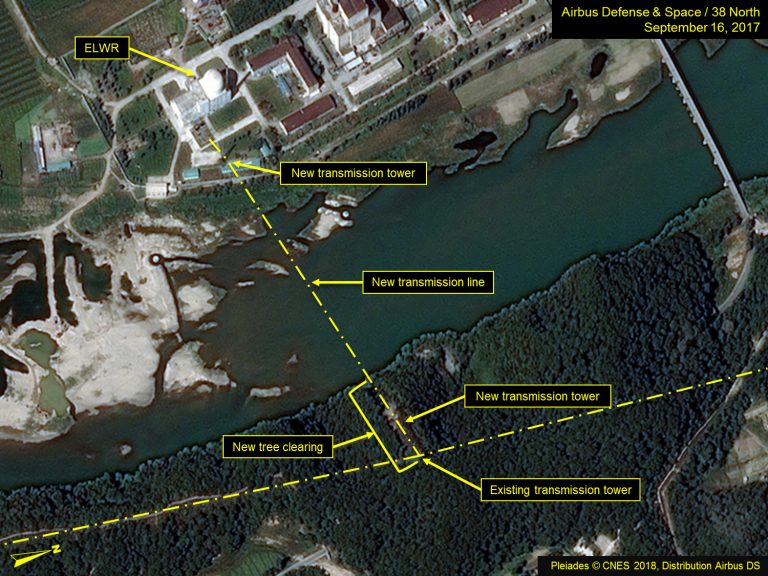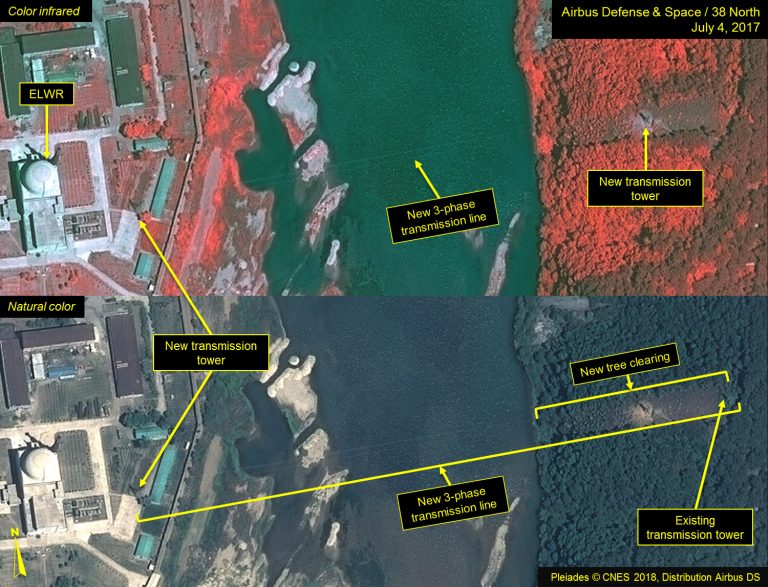Progress at North Korea’s Experimental Light Water Reactor at Yongbyon
Commercial satellite imagery from 2017 through February 11, 2018 indicates steady progress has been made towards the operationalization of the (100 MWth/30 MWe[1]) Experimental Light Water Reactor (ELWR) at North Korea’s Yongbyon Nuclear Scientific Research Center. Having been under construction since 2010, the ELWR seems to be nearing operational status based on improvements made over the past year, including new provisions for a more consistent cooling water supply, installation of internal equipment and the connection of the reactor to the local electrical grid. The latest imagery from February 11 shows the ELWR is externally complete, while the two adjacent construction support yards now appear relatively quiet as opposed to mid-2017 when equipment was actively being transferred from the yards into the reactor dome.[2] The overall site remains clean and well maintained with roads and paths cleared of recent (post-January 30, 2018) snowfall.
The February 11 image (Figures 1 and 2) also shows ice melt along the river adjacent to the reactors with steam/vapor emanating from the generator hall of the 5 MWe reactor (Figure 3), which, despite the lack of a visible cooling water outfall, is suggestive of at least partial recent operations. The 5 MWe plutonium production reactor is well maintained and has been operational over the past year, although intermittently or at low levels. Based on the latest and other recent imagery, it is not possible to conclude whether the reactor was defueled/refueled at the end of its predicted operations cycle finishing in late 2017.[3]
Figure 1. Overview of the Yongbyon Nuclear Scientific Research Center Area.
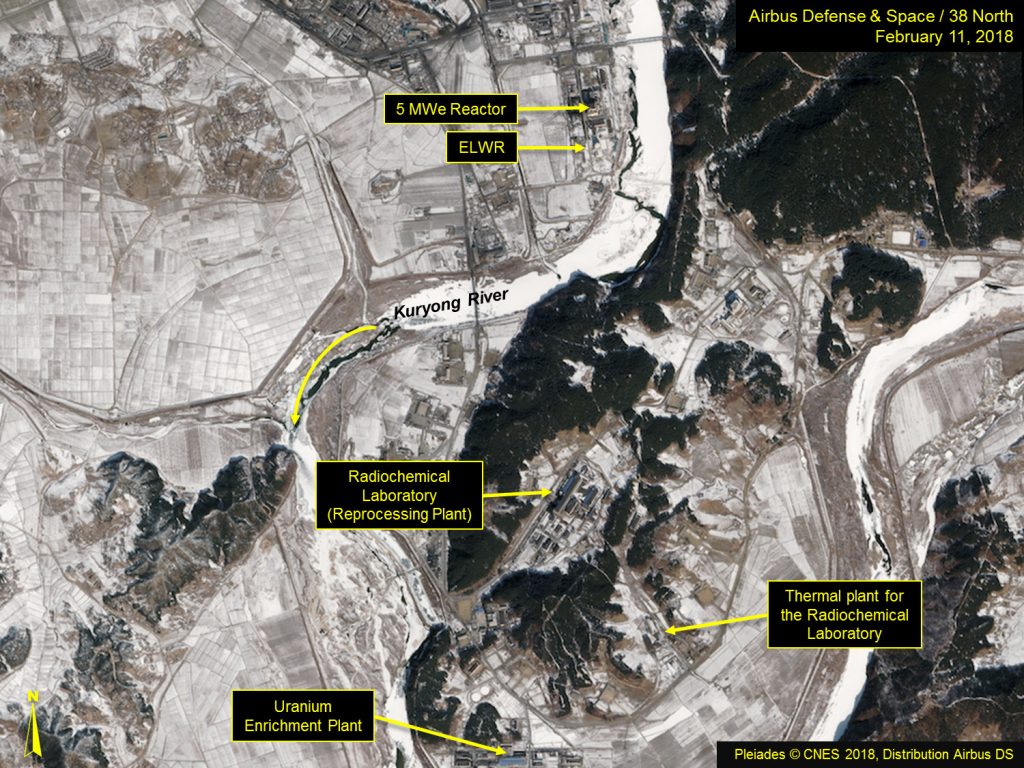
Figure 2. Ice melt visible adjacent to 5 MWe Reactor and ELWR.
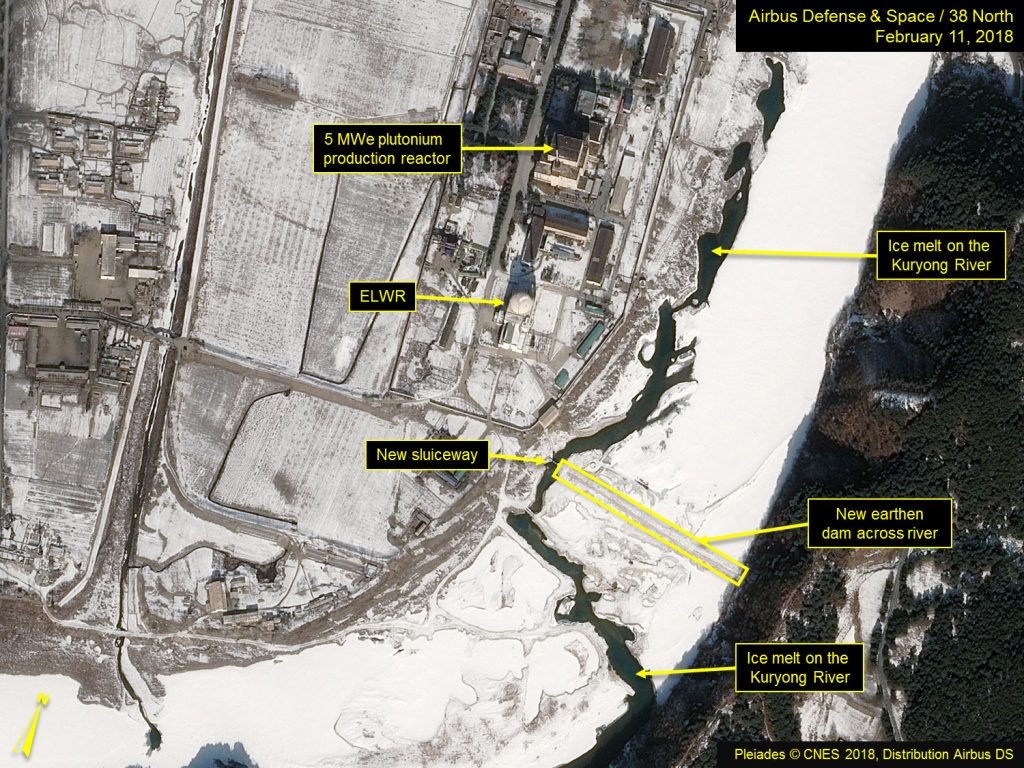
Figure 3. Steam/vapor plumes emanating from generator hall of 5 MWe reactor.
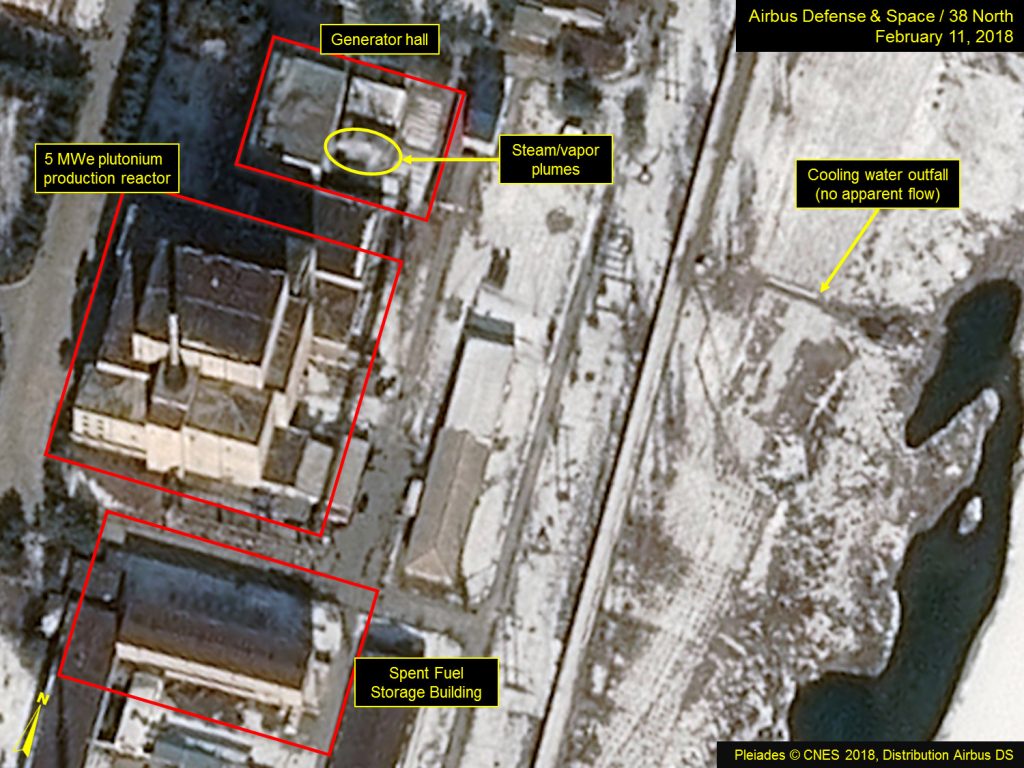
Progress on the ELWR
Among the most notable changes over the past year is the construction of an earthen dam with a sluiceway across the Kuryong River (Figure 4), which was built to retain sufficient water levels to provide consistent flows for the cooling of the ELWR (via two cisterns located in the river) in advance of the reactor becoming operational. The earthen dam was constructed just downriver below the second cistern in late December 2017 into January 2018.
The 2017 International Atomic Energy Agency (IAEA) safeguards report noted indications of an increase in activities in the ELWR’s construction yard consistent with the fabrication of certain reactor components.[4] Based on satellite imagery alone, it is difficult to identify what these specific “reactor components” were, however, significant movement of equipment was observed over the past year at the two construction support yards (primary and secondary) presumably in preparation for installation in the reactor. The heavy-lift (double-girder, ~60 ton) traveling crane in the primary ELWR construction support yard moved repeatedly between successive images from late May to September 2017 with little subsequent change through February 11, 2018 (Figures 5-10). In the secondary construction support yard, the smaller traveling crane (single girder, <20 ton) also showed similar movements throughout the year (Figure 11). That activity is also consistent with the observations by others of significant movement of large, likely critical, equipment, possibly including reactor components, outside of the fueling port/service crane-way at the north side of the ELWR dome from late April through late August 2017 (some of which involved the use of a temporary tower crane).[5] Also noteworthy is that three material storage warehouses were constructed in the primary construction support yard last September, which could be used to house smaller pieces of equipment and parts for future maintenance and repair.
Although satellite imagery indicated the ELWR’s electrical switchyard was completed by May 2016,[6] footings for the key transmission tower were first noted in March 2017. A 3-phase transmission line was later strung between that newly erected tower and another located to the east across the Kuryrong River through a newly tree-cleared path to connect with an existing north-south transmission line that serves the Radiochemical Laboratory and the Uranium Enrichment Plant (UEP). (Figures 12-14)
Figure 4. New earthen dam with sluiceway constructed across Kuryong River.
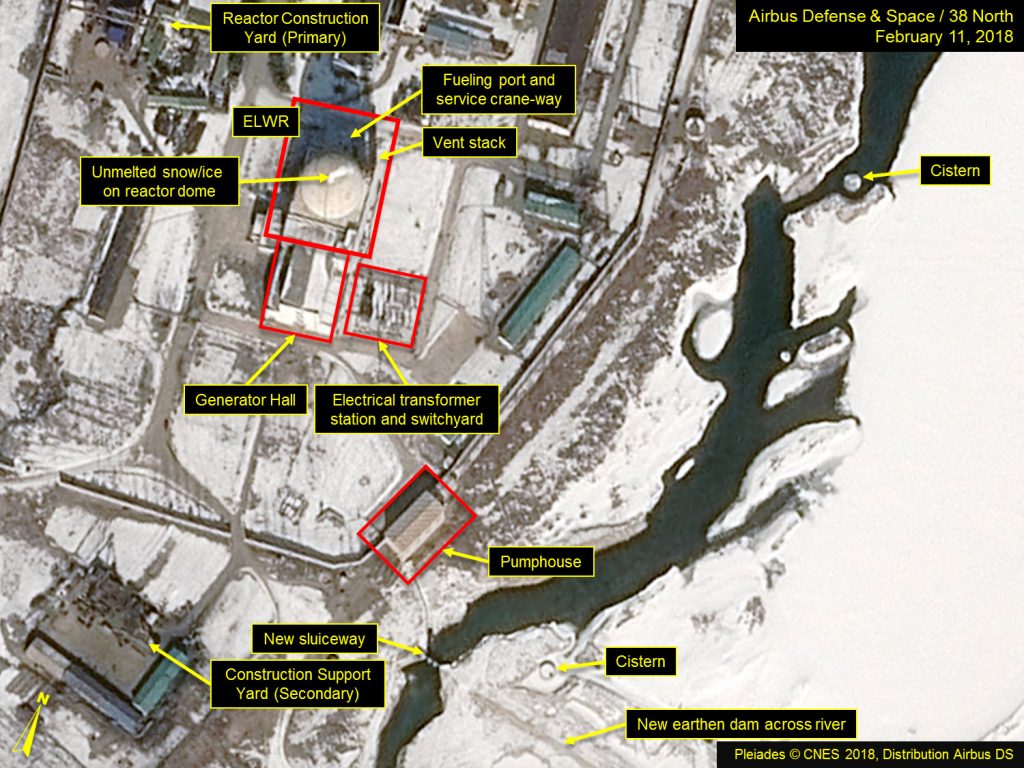
Figures 5-10. Equipment movement observed at primary ELWR construction support yard from mid-2017 to February 2018. Note: Hover over slideshow and click on left/right arrows to navigate.
Figure 11. Movement of smaller traveling crane observed at secondary ELWR construction support yard.
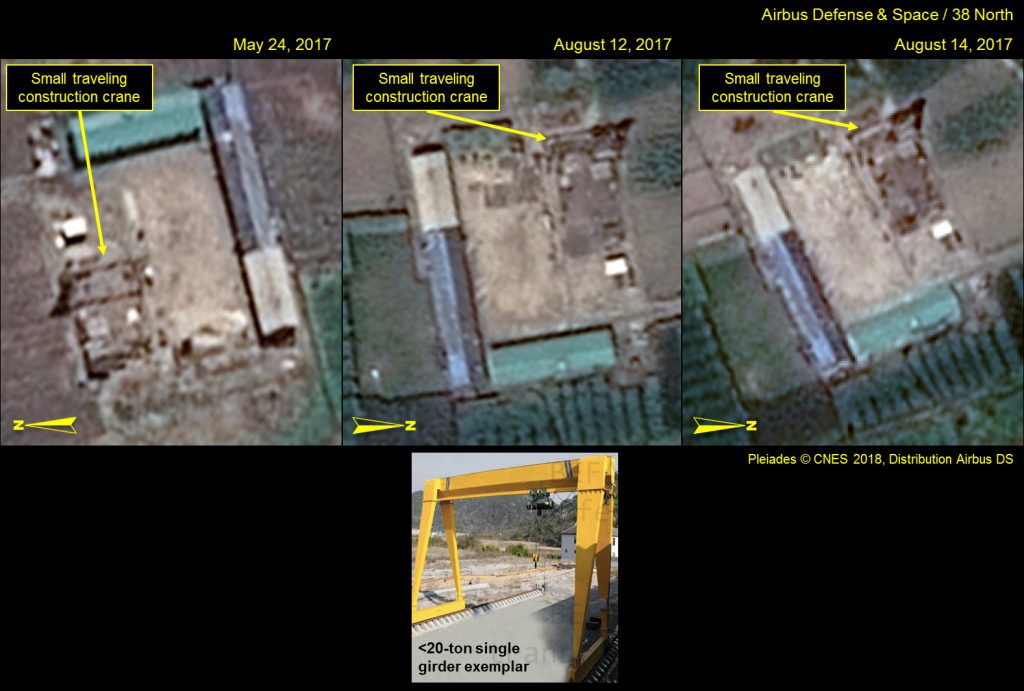
Figures 12-14. New transmission line strong across Kuryong River.
5 MWe Reactor
Over the past year, satellite imagery has shown evidence of operations at the 5 MWe Reactor in the form of vapor emissions/steam discharges, cooling water outfalls, or ice melt on electro-optical imagery. However, a near monthly review of low-resolution thermal infrared imagery indicated that the reactor had either been operating only intermittently at a low-level or not operating over much of the past two years. The notable exception to this was in December 2016 and January 2017 when thermal patterns suggested a higher than normal level of operations, with warm water effluent from reactor cooling operations flowing downstream along the Kuryong River.[7] (Figure 15)
Figure 15. Higher level thermal signatures visible in December 2016.
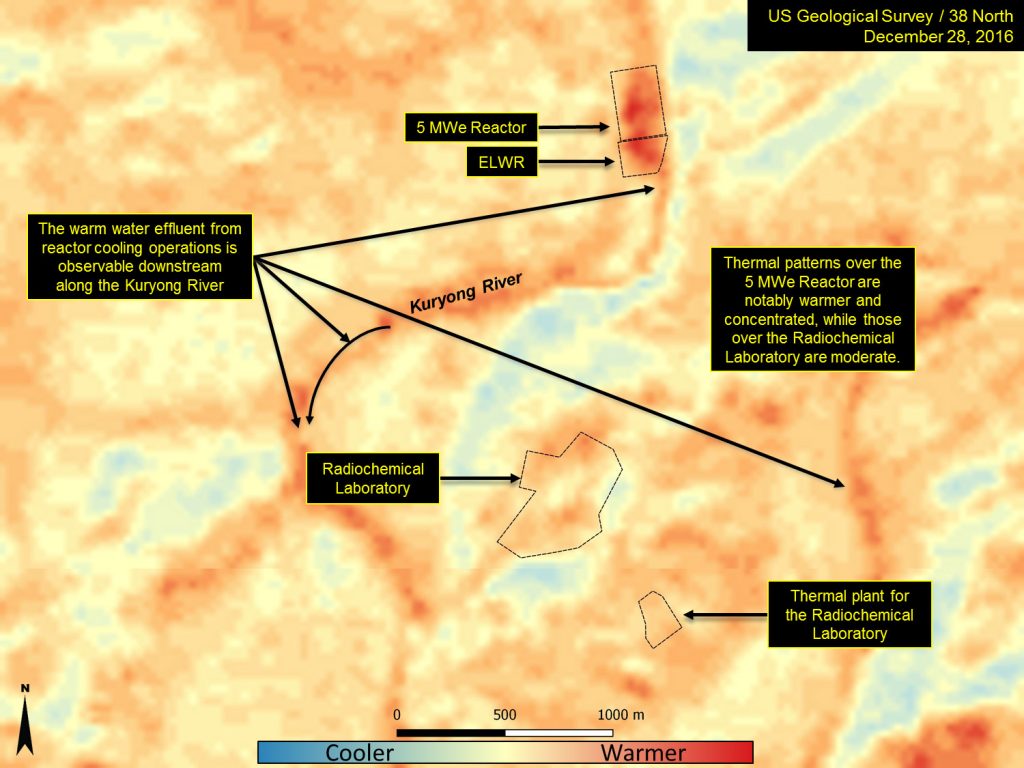
Other Facilities
Rail cars, including flat cars loaded with chemical tanks, have been routinely observed near the Isotope (e.g., Tritium) Production Facility and its related thermal plant over the past year, consistent with reprocessing or refueling campaigns. Notably, on the February 11, 2018 image, unique “specialized” rail cars are present at the Pungang-ni Rail Yard (the main rail yard serving Yongbyon). Three specialized depressed-well flatcars, which have been observed at both the Radiochemical Laboratory and the southeast rail yard during previous reprocessing or refueling campaigns,[8] are present in the main rail yard. The angle is not sufficient to tell whether there is a fourth flatcar with a box or “cask” for purposes unknown that has previously been observed with the three specialized rail cars (Figure 16). The last reprocessing campaign at the Radiochemical Laboratory was thought to have been completed in mid-2016, but it may have only processed a portion of the spent fuel rods from the 5 MWe Reactor.[9]
Throughout the last year, personnel have been seen throughout the site, indicating a high level of activity. On the latest image, a somewhat unusual formation of about 30 personnel can be seen in the courtyard of the open support area, but given the evenly distributed pattern, it may only have been for something as innocuous as physical training and exercise drills (Figure 17).
Figure 16. Specialized rail cars present at the main rail yard.
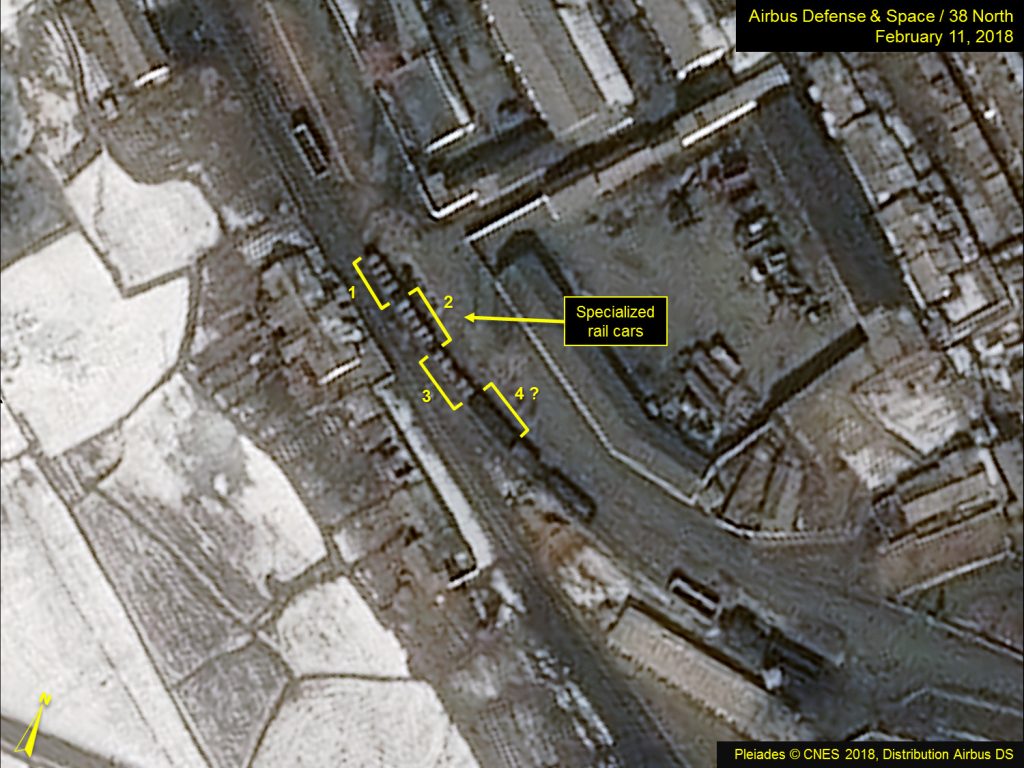
Figure 17. Group of personnel in formation observed at open support area.
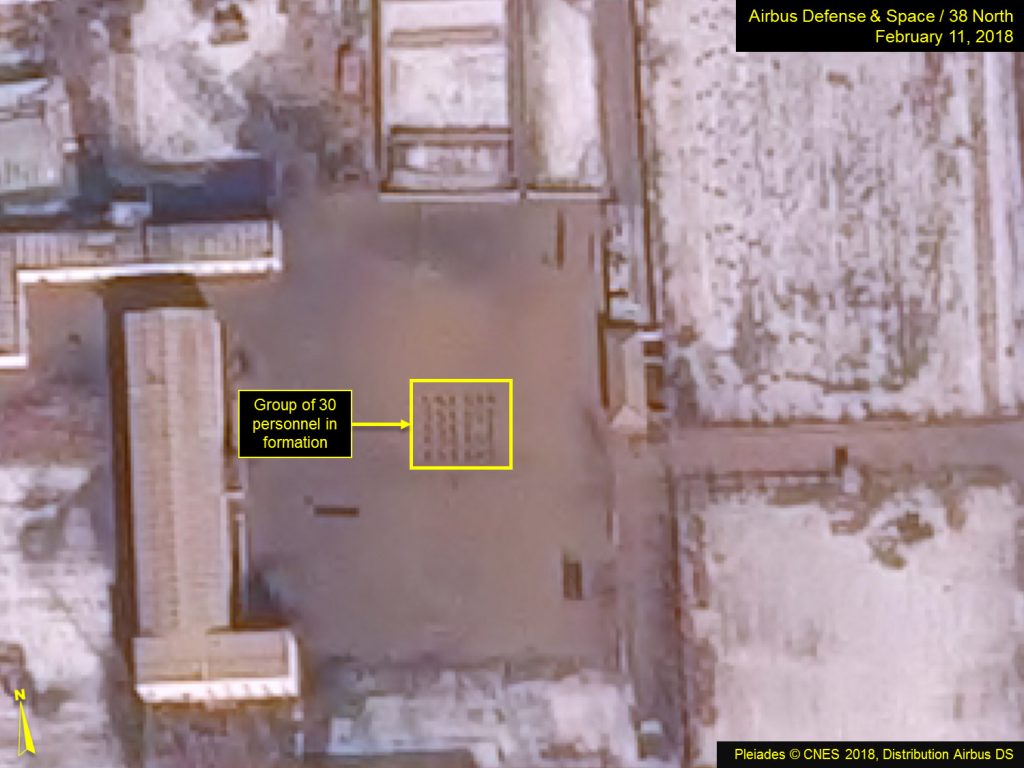
- [1]
According to Dr. Siegfried Hecker (who last visited Yongbyon in late 2010), the reactor was to have a design capacity of 100 megawatts thermal (MWth) and generate electricity with at 30 percent efficiency, hence 30 megawatts electric (MWe). See: Chaim Braun, Siegfried Hecker, Chris Lawrence, Panos Papadiamantis, “North Korean Nuclear Facilities After the Agreed Framework,” Center for International Security and Cooperation, May 27, 2016, 18-19, http://cisac.fsi.stanford.edu/sites/default/files/khucisacfinalreport_compressed.pdf.
- [2]
David Albright, Sarah Burkhard, and Allison Lach, “On-Going Monitoring of Activities at the Yongbyon Nuclear Site,” Institute for Science and International Security, February 13, 2018, http://isis-online.org/isis-reports/detail/on-going-monitoring-of-activities-at-the-yongbyon-nuclear-site.
- [3]
“Report by the International Atomic Energy Agency Director General, Application of Safeguards in the Democratic People’s Republic of Korea,” GOV/2017/36-GC(61)/21, IAEA, August 25, 2017, https://www.iaea.org/About/Policy/GC/GC61/GC61Documents/English/gc61-21_en.pdf.
- [4]
The DPRK is technically still obligated to maintain IAEA safeguards in perpetuity on at least the two nuclear research facilities at Yongbyon: the IRT Research Reactor and a critical assembly, which North Korea obtained from the Soviet Union under INFCIRC 66/Rev.2 signed in 1977. As such, the IAEA also remains obligated to continue to verify the application of safeguards on at least those facilities, despite the DPRK’s withdrawal from the Nuclear Nonproliferation Treaty (NPT) in December 2002, negating its comprehensive Safeguards Agreement and expelling IAEA inspectors. (Note: IAEA inspectors were temporarily allowed back into the DPRK from July 2007 to April 2009, during the so called “Disablement” period.)
- [5]
See for example, Allison Puccioni and Elliot Serbin, “North Korean ELWR makes progress towards Operations,” Jane’s Intelligence Review, January 3, 2018, http://www.janes.com/images/assets/853/76853/North_Korean_ELWR_makes_progress_towards_operations.pdf, and David Albright, Sarah Burkhard, and Allison Lach, “On-Going Monitoring of Activities at the Yongbyon Nuclear Site,” Institute for Science and International Security, February 13, 2018, http://isis-online.org/isis-reports/detail/on-going-monitoring-of-activities-at-the-yongbyon-nuclear-site.
- [6]
Joseph S. Bermudez Jr., “New Evidence of Probable Plutonium Production at the Yongbyon Nuclear Facility,” 38 North, May 31, 2016, https://www.38north.org/2016/05/yongbyon053116/.
- [7]
Joseph S. Bermudez Jr., Mike Eley, Jack Liu, and Frank V. Pabian, “North Korea’s Yongbyon Facility: Probable Production of Additional Plutonium for Nuclear Weapons,” 38 North, July 14, 2017, https://www.38north.org/2017/07/yongbyon071417/.
- [8]
Bermudez et. al, “North Korea’s Yongbyon Facility: Probable Production.”
- [9]
Joseph S. Bermudez Jr., “Continued Activity at Key Plutonium Production Facilities at North Korea’s Yongbyon Nuclear Comples; Purpose Unclear,” 38 North, March 28, 2017, https://www.38north.org/2017/03/yongbyon032817/.

